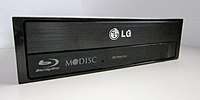M-DISC
M-DISC (Millennial Disc) is a write-once optical disc technology introduced in 2009 by Millenniata, Inc.[1] and available as DVD and Blu-ray discs.[2]
 | |
| Media type | write-once optical disc |
|---|---|
| Standard | DVD, Blu-ray |
| Developed by | Millenniata, Inc. |
| Dimensions | Diameter: 120 mm (4.7 in) |
| Usage | Archival storage |
| Extended from | DVD+R, BD-R |
| Released | 2009 |
Overview
M-DISC's design is intended to provide greater archival media longevity.[3][4] Millenniata claims that properly stored M-DISC DVD recordings will last 1000 years.[5] The M-DISC DVD looks like a standard disc, except it is slightly thicker and almost transparent.
Compatibility
M-Discs are readable by most regular disc drives.[6]
History
M-DISC developer Millenniata, Inc. was co-founded by Brigham Young University professors Barry Lunt[7] and Matthew Linford,[8] along with CEO Henry O'Connell and CTO Doug Hansen.[9] The company was incorporated on May 13, 2010 in American Fork, Utah.[1]
Millenniata, Inc. officially went bankrupt in December 2016. Under the direction of CEO Paul Brockbank, Millenniata had issued convertible debt. When the obligation for conversion was not satisfied, the company defaulted on the debt payment and the debt holders took possession of all of the company's assets. The debt holders subsequently started a new company, Yours.co, to sell M-DISCs and related services.
Materials technology
While the exact properties of M-DISC are a trade secret,[10] the patents protecting the M-DISC technology assert that the data layer is a "glassy carbon" and that the material is substantially inert to oxidation and has a melting point between 200 and 1000 °C.[11][12]
M-DISC uses a single inorganic recording layer, which is substantially inert to oxygen, but requires a higher-powered laser. M-DISC DVD does not require the reflective layer. Thus, both the M-DISC and inorganic BD-R physically alter the recording layer, by burning or etching a permanent hole in the material, rather than changing the color of a dye. Besides physical damage, the primary failure modes of all optically recordable disks are failure of the reflective layer, followed closely by degradation of the data layer.
Durability claims
According to Millenniata, the U.S. Naval Air Warfare Center Weapons Division of the U.S. Department of Defense found that M-DISC DVDs are much more durable than conventional DVDs. "The discs were subject to the following test conditions in the environmental chamber: 85 °C, 85% relative humidity (conditions specified in ECMA-379) and full spectrum light".[13][14]
According to an accelerated aging test of the French National Laboratory of Metrology and Testing at 90 °C and 85% humidity, the DVD+Rs with inorganic recording layer like M-DISCs were still readable after 250 hours, however with an error rate above threshold, and were rated "less than 250 hours" equivalent to competing offers. The performance was: better than several DVD brands using organic dyes, where discs were not always readable after 250 hours; slightly lower than another brand which achieved a lower read error and was rated "250 hours"; much less than glass DVD technology (Syylex) which was rated "more than 1000 hours".[15]
Commercial support
Recorded discs are readable in most conventional drives. Available recording capacities are similar to other optical media from 4.7 GB DVD-R to 25 GB, 50 GB BD-R and 100 GB BD-XL. Due to their translucency (lack of a reflective layer), the first DVD M-DISCs had difficulty distinguishing the writable side of the disc, so color was added to distinguish the sides and make it look like the coloring on standard DVD media.
Asus, LG Electronics, Lite-On, Pioneer, and Verbatim[16] produce drives that can record M-DISC media. Ritek produces M-DISC Blu-ray media, sold under the Ritek and M-DISC brands. Verbatim produces co-branded discs, marketed as the "Verbatim M-DISC".[17][18]
 M-DISC optical storage medium transparency demonstration
M-DISC optical storage medium transparency demonstration M-DISC medium in an open case
M-DISC medium in an open case
References
- "Springville company introduces new DVD to protect data for a thousand years or more" Daily Herald. Retrieved 17 July 2009.
- New 1,000-Year DVD Disc Writes Data in Stone, Literally
- "Final Report for Millenniata DVD Testing August 2009-October 2009", Naval Air Warfare Center Weapons Division. Retrieved 10 November 2009.
- Will Today’s Digital Movies Exist in 100 Years?
- "Front Page". Archived from the original on 2018-08-16. Retrieved 2013-03-08.
- M-Disc FAQ by disc manufacturer RITEK
- "Barry Lunt Website". Archived from the original on 2013-10-16. Retrieved 2012-10-12.
- "Matthew Linford Website". Archived from the original on 2018-08-17. Retrieved 2014-07-23.
- Douglas Hansen Biography Archived 2012-05-01 at the Wayback Machine
- mDisc Review Archived 2014-08-21 at the Wayback Machine.
- "Optical data storage media containing substantially inert low melting temperature data layer US 8389095 B2", Patent US 8389095. Retrieved 2020-05-25.
- "Long-term digital data storage US 7613869 B2", Patent US 7613869. Retrieved 2020-05-25.
- "75 page breakdown of the D.O.D.'s findings"
- "2 page summary of DOD's findings" Archived 2017-09-13 at the Wayback Machine.
- "5.4. SUMMARY OF THE TESTS ON ACCELERATED AGING".
- "Lite-On eBAU108 Product Information". Lite-On Corp. Retrieved 19 February 2014.
- "Millenniata Archiving Blu-ray M-Disc Available in Spring 2013" Archived 2013-09-15 at the Wayback Machine. StorageNewsletter.com. Retrieved 10 January 2013.
- "M-Disc's list of devices that can write Archived 2014-03-25 at the Wayback Machine.